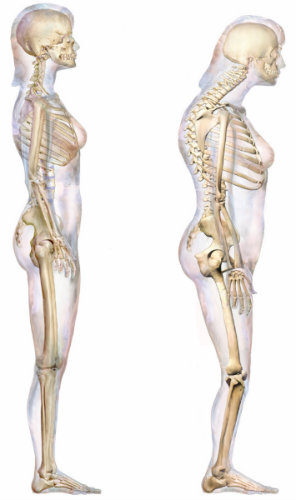 Reading Time: 3 minutes
Reading Time: 3 minutesFor most of us, our thoracic spine takes a beating in our day-to-day lives. When you add up all the time we spend sitting in the car, at a desk, and on the couch, the thoracic spine doesn’t get a lot of movement. In fact, it primarily stays in a rounded position that limits its own ability to rotate and allow full range of motion of the shoulders.
Health issues involving the thoracic spine usually start with poor posture and are common for most Americans. Over time, poor posture can compound into a number of health issues:
- Soreness and pain related to strain in the lower back.
- Poor circulation from being static for long periods.
- Carpal tunnel syndrome from the compression of nerves in the neck and upper back.
- Poor digestion from the compression of the internal organs.
- Fatigue from the body having to support an unnatural position.
For adults over forty, the health of their thoracic spine is an issue we need to address sooner rather than later. Odds are you’ve accumulated a lot of practice time with poor posture over the years. But all hope is not lost. This is something that can be corrected with time and consistent effort — if you start now.
The Thoracic Spine and Hyperkyphosis
If the health of the thoracic spine isn’t addressed, it will become increasingly harder to correct and even impossible to do so after a certain time. Once the spine has been in a certain position for a long enough period, the vertebrae will form to that shape and no amount of correction can fix it.
 Have you ever seen an elderly adult who couldn’t stand upright? The clinical term for this condition is hyperkyphosis. Kyphosis means an excessive outward curvature of the spine, causing hunching of the back. Another name for it you may have heard is “dowager’s hump.”
Have you ever seen an elderly adult who couldn’t stand upright? The clinical term for this condition is hyperkyphosis. Kyphosis means an excessive outward curvature of the spine, causing hunching of the back. Another name for it you may have heard is “dowager’s hump.”
While we often see this end result in the elderly, the development of this condition begins much earlier in life. According to the U.S. National Institutes of Health’s National Library of Medicine, kyphosis can increase from vertebral fractures, degenerative discs, and muscle weakness. Women are also shown to be at higher risk than men.
Long term this can be a dangerous situation for adults and lead to serious potential health risks. Along with an increased likelihood of vertebral fractures, degenerative disc disease, and muscle weakness, there can be decreased mobility and sensory impairment. This severely limited ability to move and perform daily tasks coupled with a high risk of falling, can lead to the need for in-home care or residence in a nursing facility.
So if we want to remain independent and healthy for as long as possible, then caring for our thoracic spine becomes critical.
How to Start Caring for Your Thoracic Spine
All these long-term health issues can be mitigated, if not eliminated, if we start working at it today. There are a number of things we can do to improve the health of our thoracic spine. Regular movement, quality exercise, consistent mobility work, and conscious awareness of our posture are all facets of this issue that need addressing.
Last month, I wrote a piece about improving forearm mobility, and I mentioned how it can be related to the thoracic spine and poor posture. Today, I’m going give you another piece of the puzzle and show you how to foam roll your upper back.
When done consistently, this exercise should improve posture, shoulder mobility, and rotation of the thoracic spine. This isn’t the cure-all for hyperkyphosis, but it is an important aspect of addressing the health of your spine. Use it as a starting point for establishing the habits that will keep you active and healthy into your twilight years.





